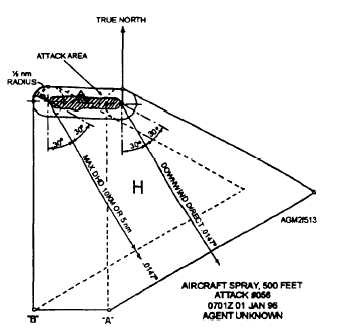with a "to" or “through” statement (such as "point A to
point B"), plot the attack area as follows:
Draw %-nautical-mile-radius circles at both the
beginning and end points in a spray line. Regard the two
circles as being two separate attack areas.
Draw two tangent lines connecting the circles
(one upwind and one downwind).
As shown in figure 5-13, the hazard area is plotted
by drawing a line representing the chemical downwind
direction from the center of both circles, representing
the beginning and ending points of the attack. Mark the
DHD on each CDD line. Usually, the DHD for a
ground-contaminating agent is 10 nautical miles;
however, check element ZEBRA-BRAVO and use the
DHD provided.
Draw two radial lines tangent to each
circle using the half-sector angle given in the message
(or 30°). Draw lines perpendicular to the CDD lines at
the marked DHD to form two triangular areas. Connect
the apexes of the two resulting triangular hazard areas
between points A and B, as shown to complete the
hazard area.
The three situations we have discussed represent
the basic plots of different hazard areas that could result
from a chemical attack. Changes in wind speed and/or
wind direction may require a reevaluation of the hazard
area boundaries. Reevaluation is normally done by the
forecaster or the personnel in the NBC center, and a
supplemental NAV NBC 3 CHEM message is normally
transmitted to cover the new areas. When a reevaluated
NBC message is received with the same attack serial
number and date-time of the attack message that has
already been plotted, you should plot the new
boundaries over the old hazard boundaries, possibly in a
different color, and note the new information alongside
the plot.
REVIEW QUESTIONS
Q22. What are the two types of chemical hazard
messages of most concern to Aerographers?
Q23.
What information is contained in element "PA"
of an NBC 3 CHEM message?
Q24.
What information is contained in element "ZB"
of a NAV NBC 3 CHEM message?
Q25. What would the code "217981" indicate in
element "ZA" of a NAV NBC 3 CHEM message?
Q26.
Q27.
Q28.
How should a chemical hazard area be plotted
for a Type "A" attack when the average wind
speed is 5 knots or less?
What information must be obtained from an NBC
3 CHEM message in order to plot a triangular
chemical hazard area?
When is a double triangular chemical hazard
area plotted?
SUMMARY
There are several different types of messages
related to NBC warfare. Various graphic products can
be completed from these messages for NBC planning
and briefing purposes. Most of these products can be
rapidly produced from TESS. In this chapter, we have
discussed the terms used to describe various aspects of
NBC warfare and discussed in detail the elements of
NBC messages you are most likely to encounter. We
also described the manual methods for producing NBC
hazard prediction plots.
Figure 5-13.—Double-triangular hazard area. Plotted type
B-case (c) chemical attack.
5-16



